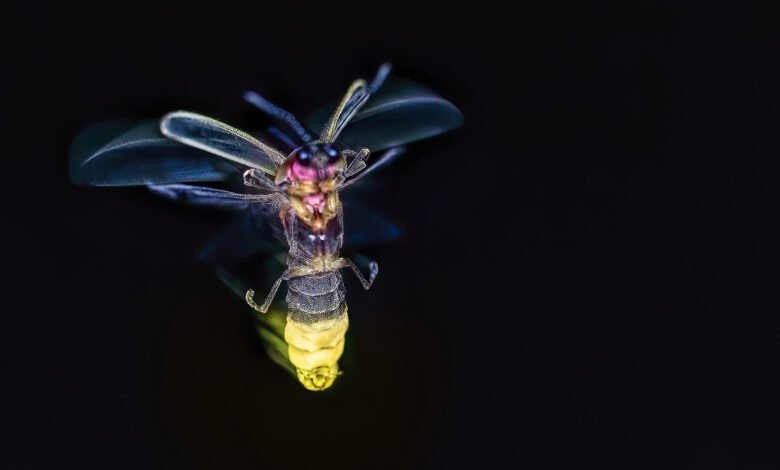A new theory about why fireflies glow and why they need help

Their ethereal yellow (or green, or red) glow emerging from the grass signals summer. Although there may be as many as 2,400 species of fireflies on Earth, these flying, bioluminescent insects are under threat. Worsening habitat conditions could mean more summers with fewer fireflies.
Recently, scientists have also begun to question the prevailing hypothesis about why they evolved their glow in the first place. New analyses at the genetic level could be crucial in helping fireflies meet their survival challenges, as they may need to evolve once again.
[Related: How do fireflies power their blinking butts?]
A new hypothesis about how fireflies got their glow
For years, scientists believed that the bright lights emitted by fireflies in the LampyridaThe family first evolved as a warning signal to predators. Their distinctive glow would signal that they were toxic and likely wouldn’t taste very good. Over time, this light was potentially repurposed as a mating signal.
In a recent study published in the journal PNAS NexusA team in China put this to the test by modeling a firefly family tree using genetic data. They traced the evolution of the chemical compounds that make fireflies toxic—lucibufagins. They collected samples from 16 firefly species. Lampyridae from across China and with two related species. In addition to performing a full genetic analysis of each species, they also looked for lucibufagins using liquid chromatography-mass spectrometry. This process is used in a laboratory to separate, identify, and measure what substances are present in a liquid sample.

They found that lucibufagin toxins are present in only one subfamily of fireflies, and that it may have evolved later. However, bioluminescence itself without this toxin is found widely across the family. According to the team, this suggests that the toxin evolved after bioluminescence itself evolved in animals, and in response to something other than mating.
Instead, their glow may have evolved due to a particularly stressful situation. An ingredient in firefly bioluminescence called luciferin has antioxidant properties. The study found that firefly ancestors evolved and diversified when atmospheric oxygen levels rose from a historic low following the Toarcian Oceanic Anoxic Event. This mass extinction event about 183 million years ago during the Early Jurassic caused a widespread decrease in oxygen in the world’s oceans.
[Related: Mass extinction 183 million years ago offers dire warning for modern oceans.]
Luciferin may have been a way for fireflies to cope with less oxygen in the air. Glowing millipedes are also thought to have evolved bioluminescence as a way to cope with oxidative stress in hot, dry environments. Fireflies may also have followed a similar path in response to the stress of oxygen depletion.
Today’s least predictable weather
While fireflies may have evolved this glow as a response to low oxygen millions of years ago, what does this mean in light of today’s environmental challenges? They typically thrive in temperate conditions. Warm, humid summers create their ideal breeding environment, with cold winters supporting the survival of their eggs, larvae and pupae.
As global temperatures continue to rise, these weather conditions are becoming less predictable. For fireflies and countless other species, this means the planet is often less hospitable. Changes in precipitation patterns have also contributed to severely dry conditions that reduce larval survival, or a scenario with too much water that can flood their breeding grounds and disrupt life cycles.
A study published in the June 2024 issue of Total Environmental Science suggests that they are sensitive to a number of environmental factors, including short-term climate conditions, long-term climate trends, and urban encroachment.

“Subtle changes in weather patterns, especially related to temperature, are significantly impacting firefly breeding cycles and habitat quality,” study co-author and University of Kentucky ecologist Darin McNeil said in a statement.
Using AI-based machine learning techniques, the team analyzed more than 24,000 surveys conducted by the citizen science initiative Firefly Watch, now called Firefly Atlas. The analysis revealed that not only are the planet’s incredibly wild weather patterns harming fireflies, but human encroachment is also taking a toll. They found that fireflies are less common in areas with significant light pollution at night.
[Related: Why artificial light—and evolution—trap moths.]
However, they found that recent declines in firefly populations are not uniform across species or geographic regions. Some species have adapted to drier environments or those with specific breeding patterns may not be as affected by certain changes, while others are more vulnerable. This pattern shows how complex natural ecosystems are and why conservation strategies are not simple, one-size-fits-all solutions.
How to help fireflies
Although they are not considered threatened, their numbers are declining.
“I would say fireflies are threatened due to habitat loss, but they are not extinct, some are adapting in different regions,” said entomologist Eric Day. Virginia Tech News.
To help, entomologists recommend providing fireflies with additional habitat by incorporating wild or native plant species into your yard or garden. University of Delaware entomologist Doug Tallamy’s Native Plant Finder website is a great resource for finding out which plants are native to your area. Gardeners and homeowners should also avoid using pesticides whenever possible. These can not only degrade habitats, but kill fireflies and their prey.
Turning off unnecessary outdoor lights, especially during the summer, can also help. These lights not only confuse fireflies, but also moths and other nocturnal species.
“That’s why we see fewer and fewer of them every year. The more development there is, the less space there is for them to thrive,” Day said. “The presence of fireflies indicates a diverse habitat, and doing these things is essential to ensuring that future generations can enjoy the natural wonder of firefly-lit skies.”




